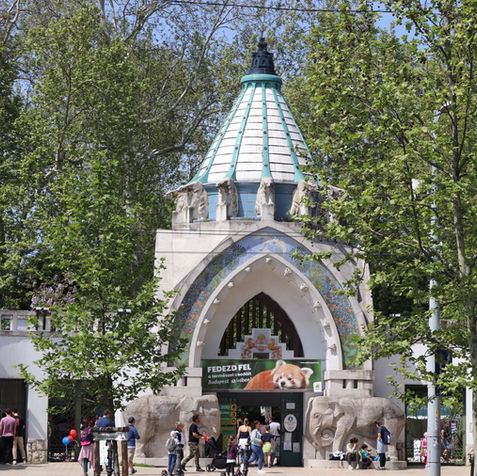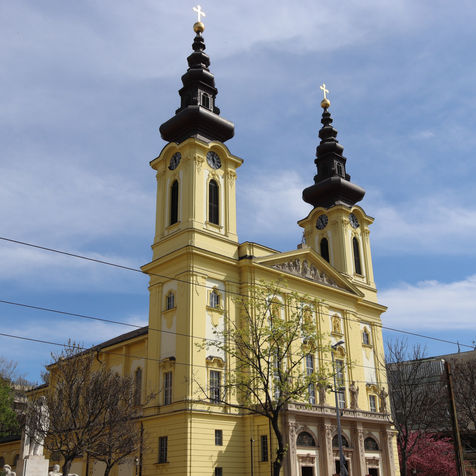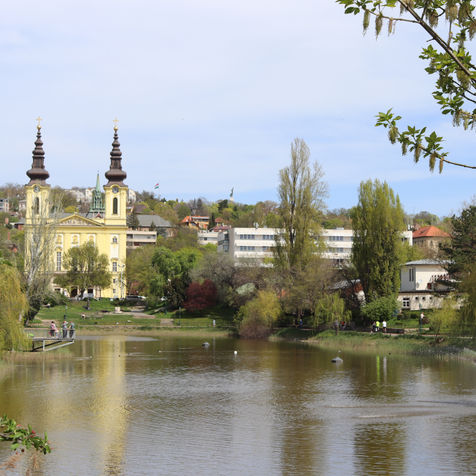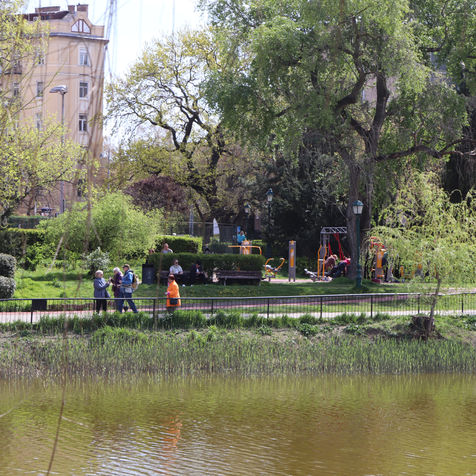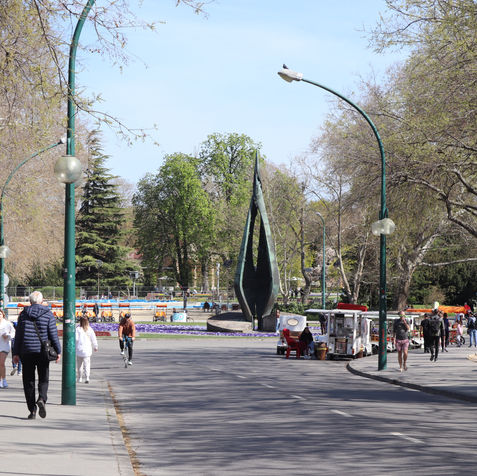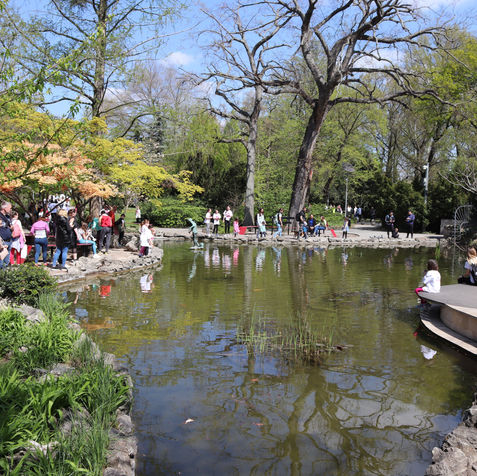Welcome to my photography site
My site
Over the next 4 photoseries, join me on the City Park tour, which is starting at the Ajtosi Durer Street and it is ending at the City Park Lake. City Park is the largest park in Budapest, which offers many walking path and relaxation opportunity. I will show you a hiking trail.
We enter into the City Park from the Ajtosi Durer Street side. Upon arrival, visitors can see a nice-designed playground. Continuing along the path, we encounter the Millennium House, a Neo-Renaissance-style building originally constructed in 1885 and it was renovated in the late of the 2010s. Today, it hosts cultural exhibitions and there are a café and a restaurant inside also. If we observe the building’s exterior, we can admire many beautiful decorative elements.
In the garden of the Millennium House, the park offers benches where visitors can relax. In addition, we can enjoy the well-maintained gardens also. As we proceed, we reach the House of Music, which is a modern building, what was built in the late of the 2010s. Its distinctive architectural design makes a point of interest. The surrounding green spaces further enhance the experience, offering a tranquil environment. Inside, visitors can explore interactive exhibitions and attend live musical performances.

As we continue our walk, the Museum of Etnography comes into view among the trees. Completed in the late 2010s, the building is notable for its distinctive ship-like design. One unique part of the building is the rooftop, which offers visitors panoramic views of the surrounding landscape.
As we ascend, it is well worth pausing to take in the scenery—picturesque views of the nearby parks, the museums surrounding Heroes’ Square, and Dozsa Gyorgy Road. On clear days, the Buda Hills can be seen in the distance also.
Continuing past the museum toward Heroes’ Square, we arrive at the museum’s main entrance. Along the way, visitors can admire an impressive facade installation, which is composed of 500 000 pixels, what presents a contemporary reinterpretation of 20 Hungarian and 20 international ethnographic motifs.
A short distance further toward Heroes’ Square, the richly ornamented rear facade of the Hall of Art comes into view.

After a short walk, we arrive at Heroes' Square, one of Budapest’s most iconic and monumental square, which is part of the UNESCO World Heritage. The square was constructed to commemorate the 1000th anniversary of the Hungarian Conquest.
Around the square, there are two significant cultural institutions: the Museum of Fine Arts and the Hall of Art. From the square, visitors can admire the stunning view to Andrassy Road, a grand avenue lined with architectural and historical landmarks.
At the heart of the square stands the Millennium Monument, featuring the statues of the seven Hungarian chieftains who led the Hungarian tribes into the Carpathian Basin. Beyond them, two semicircular colonnades represent important figures from Hungarian history.
In the right colonnade, notable statues include Janos Hunyadi, known for his victories against the Ottomans, and King Matthias. Statues of Transylvanian monarches are also represented. The left colonnade features statues of Hungarian kings, such as Saint Stephen, the founder of the state, and Bela IV.
Crowning the colonnades are dramatic two-horse chariots symbolizing War and Peace, accompanied by allegorical bronze sculptures representing Work and Prosperity, and Knowledge and Glory.
From the square, visitors can also take a moment to look toward City Park, where the picturesque Vajdahunyad Castle and the dome of Museum of Hungarian Agriculture can be seen.

Continuing the walk from Heroes' Square along Zoo Boulevard, we arrive at one of Budapest's most renowned dining establishments, the iconic Gundel Restaurant. A short walk from here brings us to the Budapest Zoo & Botanical Garden, the oldest zoo in Hungary, which has been welcoming visitors since 1866.
Directly across the road lies City Park Lake. The lake's pleasant atmosphere is enhanced by willow trees, a fountain, and walking paths. Visitors can relax on benches while enjoying views of notable nearby landmarks, including the Zoo, the historic main building of the City Park Ice Rink, and the elegant Robinson Restaurant.

Over the next 3 photoseries, join me on the Feneketlen Lake tour, which is starting at the Moricz Zsigmond Square and it is ending at the Feneketlen Lake.
The tour begins at Moricz Zsigmond Square, one of Budapest’s major transportation hubs, which is available with metro, trams and buses. The square features a statue of its namesake, Zsigmond Moricz, one of the most famous Hungarian writers of the 20th century. Behind the statue, at the center of the square, stands the iconic “Moricz Zsigmond Square Mushroom” a multifunctional building with a restaurant, gallery, ticket office, and tourist information center.
From here, the route continues along Villanyi Road, offering scenic views of Eagle Hill in the distance. Along the way, we can see the neo-baroque Saint Margaret Gymnasium (it was established in 1920), whose courtyard is opened for the visitors and features a statue of Saint Margaret. Further along stands the neo-baroque Saint Imre Church. Its churchyard is freely accessible and well worth a visit.
The tour proceeds with the Kuno Klebersberg sculpture group before arriving at the Buda Cistercian Saint Imre High School's neo-baroque building.

On the way to the Feneketlen Lake, visitors first arrive at a beautifully maintained park. From the park, a staircase descends to the lake itself. Although the lake’s name suggests infinite depth, in reality it is between 4 and 5 meters deep.
The park offers a picturesque view of the surrounding buildings and the lake. We begin the tour around the lake from the left side. Visitors can observe local wildlife such as ducks and partridges and people with some luck can see grey herons also.
As the path continues, it is worth occasionally looking back to admire the Church of St. Imre. A fountain stands in the center of the lake.
The park is also well-equipped with excellent amenities, including a running track, a modern playground, an outdoor gym, and the Hemingway Restaurant.

As we continue our walk along the lake, we pass beneath willow trees, creating a good atmosphere. Shortly after, we arrive at a pier that offers a scenic vantage point from here to admire the surrounding buildings, the central fountain, and the lake's wildlife.
Further along the path, we encounter beautifully maintained walking trail. The tourisrs may also spot turtles in their natural habitat.
At the end of our walk, we come upon a uniquely shaped monument, which is the Hungarian Youth Monument. This monument serves as a World War II memorial.

Over the next 6 photoseries, join me on the Margaret Island tour, which is starting at the Margaret Bridge and it is ending at the Arpad Bridge.
As we go to Margaret Island from Margaret Bridge, it is worth taking a moment to look back and admire the impressive view, which includes the bridge itself, the Hungarian Parliament Building, and the Buda Hills. A staircase nearby also offers access to go for a stroll alongside the Danube.
As we proceed further into the island, we encounter landmarks such as the Centenary Monument and the Musical Fountain. For interesters, there are rental options available for carriages (Bringo Hinto) or small electric vehicles.
Continuing along the path, we come across beautifully arranged flower beds, followed by the Holdudvar Conference Hall. For lovers of running, the island features a dedicated 5.2 kilometer running track that circles perimeter of island.

Our journey continues at the Alfred Hajos National Swimming Pool whose building can be admired. From here, a short walk to the bank of the Danube offers a scenic view of the Buda Hills, with the Csaszar-Komjadi Swimming Pool in the foreground.
Continuing along the route, we arrive at the Zoo, where visitors can observe a variety of animals including horses, deer, ducks and other animals. Entry to the Zoo is free, and guests can pet and feed animals.
As we proceed further, we pass through expansive meadows, which is deal for a leisurely stroll or a relaxation. Later, we reach our next destination: the Palatinus Spa, Beach and Wave Bath.
If you would like to know more about Alfred Hajos National Swimming Pool and Palatinus Spa, Beach and Wave Bath, please click on the Info button!

The following section is about Margaret Island’s most significant historical site—the ruins of Dominican Monastery. This medieval monastery is renowned as the residence of Saint Margaret, daughter of King Bela IV, who lived here in the 13th century. Margaret island was named from her name. Notably, during her lifetime, the island was known as Rabbits Island.
Today, visitors can explore the ruins of the monastery, including sections where staircases allow for elevated views of the surroundings. Architectural details can be seen, for example a part of building, where there is a fountain. The site also features the grave of Saint Margaret and a dedicated memorial place for her.

As we continue our walk, we come to the Romanian-style architecture of St. Michael's Chapel. Further along the path, we encounter the historic ENSANA Grand Margaret Island Hotel, an elegant four-star hotel, which was built in the 19th century. The hotel offers some services, including wellness and an on-site restaurant. Nearby, the Margaret Island Musculoskeletal Center provides specialized care and rehabilitation for individuals who have musculoskeletal problems.

The next stop of the tour is the Margaret Island Lake. This lake is comprised of two interconnected sections, offering a beautiful environment. Several small bridges span the water, providing crossing points and enhancing the experience of exploration.
Surrounding the lake are well-maintained walking paths, ideal for leisurely strolls and for admiring the plants. The area is also rich in wildlife, home to various species of fish, ducks, and turtles. Visitors have the opportunity to feed the animals, making it a memorable and interactive experience.

Located near the lake, the Danubius Health Spa Resort building, what serves both as a hotel and a wellness center, offering a range of health and relaxation services. As we continue our walk, we arrive the Musical Fountain, which plays melodies characteristic of the late 19th and early 20th centuries in every hour.
A visit to the fountain’s observation deck is highly recommended, as it provides a beautiful view to the lake, the adjacent hotel, the Danube and Buda hills.
At the end of out tour, we arrive the Arpad Bridge, from which visitors can enjoy a panoramic view of the surrounding landscape.

Over the next 2 photoseries, join me on a downtown tour, which is starting at the Karolyi Garden and it is ending at the Museum Garden.
Karolyi Garden is near to M2 subway Astoria station.
As we approach the garden, we are greeted by an elegant gate. Upon entering, we can see many flowers, including tulips. Continuing further into the park, visitors can view the building of the Petofi Literary Museum (here there is a permanent exhibiton for the poet, Sandor Petofi), as well as the towers of the Budapest University Church, which belongs to Pazmany Peter Catholic University. In front of the building, a statue of the renowned poet, Sandor Petofi can be found.
The garden offers a variety of opportunities. There is a dedicated area for leisure activities, for example tabletennis. In addition, there is a rabbit statue also. Comfortable benches are available throughout the garden for those who wish to relax and enjoy the silent.
Besides, families with children will found the relaxation opportunity with the well-equipped playground and sandbox. For those seeking a quieter experience, the garden features walking paths and secluded seating areas, offering a peaceful retreat from the bustle of the city.

After leaving Karolyi Garden, we proceed to Museum Boulevard via Ferenczy Istvan Street. The boulevard is lined with impressive historic buildings, including the Faculty of Humanities of Eotvos Lorand University and its Institute of History. All the buildings along the boulevard up to Brody Sandor Street are part of Eotvos Lorand University.
As we continue the walk along Museum Boulevard toward Kalvin Square, we encounter the Hungarian National Museum, a classicist building, which was constructed between 1837 and 1847. Entering the Museum Garden, we are welcomed by a beautifully maintained park that provides a peaceful environment in the heart of the city.
Within the garden, visitors can view several statues, including the museum’s founder, Count Ferenc Szechenyi. The group of sculptures features the renowned poet Janos Arany, the legendary medieval hero Miklos Toldi, his love Piroska Rozgonyi, and a statue of the mythical turul bird.
Continuing the walk in the garden, there is a green space. Behind the museum building, the visitors can admire the Karolyi Palace, the statue of revolutioner Pal Vasvari, the Esterhazy Palace and the Geraldine-Auguszt Confectionery. Additionally, on Muzeum Street, what is located south of the Museum Garden, stands the Harmonia Palace Budapest Event Hall building.





































